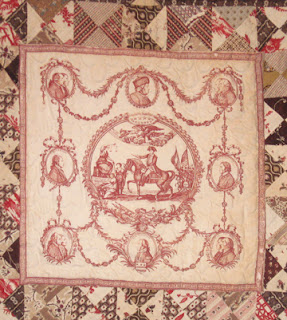Pieced Medallion (1790-1810)
from The Winterthur collection
We don't find multicolor, imported chintz panels with American commemorative images,
but there is a tradition of using single color toile-style textiles for medallion centers with a patriotic theme. The detail shows a handkerchief with Benjamin Franklin at the top and Washington in the center. It looks to be a bordered composition rather than a vignette cut from a scenic toile as in the quilt below.
See the whole quilt here:
This quilt attributed to Martha Washington in the late-18th century features a scene cut from a William Penn toile. See more about this quilt here:
The framed panels were probably printed as handkerchiefs. Quite a few handkerchiefs in the single color on white combination survive. This one includes the Declaration of Independence with the words "Just the Thing for a Child to Love." These copper-plate textiles dating to the years before 1820 MAY have been printed in the United States. Any printer could run a piece of cotton or linen through his newspaper press. But the ink was not color fast.
It took a technical sophistication to print the mordant for a permanent dye with a copper plate, skills we do not find in the United States before the War of 1812. So we assume that madder-dyed toile pieces from the 18th or early 19th centuries were done in England or France for export.
Washington's death in 1799 caused a national mourning that inspired this handkerchief, found in both red and brown colorways.
Two more Washington mourning bandanas.
Handkerchiefs were marketed as teaching tools for a children.
The Spencer Museum of Art owns a quilt from about 1825 with a child's teaching handkerchief in the center.
Masons also commissioned handkerchiefs that found their way into quilts.
Quilt with a Masonic Handkerchief
National Heritage Museum
The central textile dates to 1817.
See more about this quilt here:
Collection of the Noah Webster House
Here's a detail of a quilt from the 1780s featuring a Masonic kerchief dated AD 1769. See more about it in a newsletter from the Noah Webster House.
One exception to the idea that the permanently dyed handkerchiefs were imports is John Hewson's Washington kerchief. Printed by woodblocks rather than copperplate technology, this madder-printed square was sold in Philadelphia at the Hewson printworks in the Revolution's early years, the mid-1770s.
http://www.nyhistorystore.com/shop/accessories/george-washington-kerchief
See their original here:
http://www.nyhistory.org/node/32627
















2 comments:
On a visit to the Abby Aldrich Rockefeller Folk Art Museum at Williamsburg, they had on display a quilt with Washington's Deathbed as the center medallion.
I'll look for that on line. Thanks for the tip.
Post a Comment